| Listing 1 - 10 of 29 | << page >> |
Sort by
|
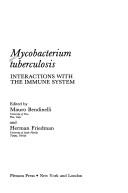
ISBN: 0306427249 9780306427244 Year: 1988 Publisher: New York (N.Y.): Plenum,
Abstract | Keywords | Export | Availability | Bookmark
 Loading...
Loading...Choose an application
- Reference Manager
- EndNote
- RefWorks (Direct export to RefWorks)
Periodical
Abstract | Keywords | Export | Availability | Bookmark
 Loading...
Loading...Choose an application
- Reference Manager
- EndNote
- RefWorks (Direct export to RefWorks)
Book
ISBN: 0306427257 Year: 1988 Publisher: New York London Plenum Press
Abstract | Keywords | Export | Availability | Bookmark
 Loading...
Loading...Choose an application
- Reference Manager
- EndNote
- RefWorks (Direct export to RefWorks)
Book
ISBN: 128060803X 9786610608034 0306486881 Year: 2005 Publisher: New York : Springer Science+Business Media,
Abstract | Keywords | Export | Availability | Bookmark
 Loading...
Loading...Choose an application
- Reference Manager
- EndNote
- RefWorks (Direct export to RefWorks)
The use of recreational drugs of abuse by large numbers of individuals in this country and abroad has aroused serious concerns about the consequences of this activity. For example, it is recognized that marijuana is currently widely used as a recreational drug in the United States as well as other countries. Similarly, abuse of cocaine, especially crack cocaine, is considered to be an epidemic. “The war on drugs” by the US Government was directly aimed at the illicit use of cocaine, marijuana, and opiates as well as other drugs of abuse. Furthermore, alcohol is also considered a major problem of abuse in this country as well as in many other countries. It is estimated there are at least 10 million alcoholics in the United States alone. A significant portion of those hospitalized with infectious diseases are alcoholics. Similarly, there have been many reports of association between marijuana use and increased susceptibility to infection as well as a reflection between use of opiates and infections. The relationship between drug abuse and increased incidence of various infections has stimulated increased investigation of whether and how such drugs affect immune function, especially important for resistance against infectious agents. During the last decades, a wide variety of studies have shown that drugs of abuse, including marijuana, cocaine, or opiates, as well as alcohol, alter both neurophysiological as well as pathological responses of individuals.
Drugs of abuse --- Immunosuppression. --- Substance abuse --- Communicable diseases --- Physiological effect. --- Complications. --- Etiology. --- Contagion and contagious diseases --- Contagious diseases --- Infectious diseases --- Microbial diseases in human beings --- Zymotic diseases --- Diseases --- Infection --- Epidemics --- Abuse of substances --- Addiction, Substance --- Addictive behavior --- Chemical dependence --- Chemical dependency --- Substance addiction --- Substance dependence --- Substance-related disorders --- Substance use disorders --- Psychology, Pathological --- Depression, Immune --- Immune depression --- Immune suppression --- Immunodepression --- Suppression, Immune --- Immune response --- Immunological tolerance --- Therapeutics --- Immunodeficiency --- Drug abuse --- Regulation --- Physiological effect --- Psychiatry. --- Immunology. --- Microbiology. --- Emerging infectious diseases. --- Infectious Diseases. --- Emerging infections --- New infectious diseases --- Re-emerging infectious diseases --- Reemerging infectious diseases --- Microbial biology --- Biology --- Microorganisms --- Immunobiology --- Life sciences --- Serology --- Medicine and psychology --- Mental health --- Infectious diseases.
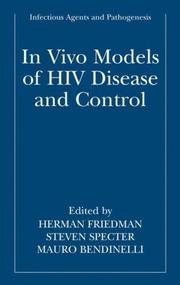
ISBN: 1280851902 9786610851904 0387257411 0387257403 148997332X 9781280851902 9780387257419 Year: 2006 Publisher: New York ; [Great Britain] : Springer,
Abstract | Keywords | Export | Availability | Bookmark
 Loading...
Loading...Choose an application
- Reference Manager
- EndNote
- RefWorks (Direct export to RefWorks)
An AIDS vaccine is still elusive and HIV treatment continues to develop multidrug resistance at alarming rates. Because of the similarities between HIV and immune deficiency infections in a variety of animals, it is only natural that scientists use these animals as models to study pathogenesis, treatment, vaccine development and many other aspects of HIV. Part of the series Infectious Agents and Pathogenesis, this volume reviews the immune deficiency virus in a variety of hosts. Pathogenesis, vaccine and drug development, epidemiology, and the natural history of the monkey, mouse, cat, cow, horse, and other animal viruses are detailed and compared to HIV. Also included are chapters on the history and future of animal models, as well as a chapter on ethical and safety considerations in using animal models for AIDS studies.
HIV infections --- HIV (Viruses) --- Animal models. --- AIDS-associated retrovirus --- AIDS virus --- ARV (Viruses) --- HTLV-III (Viruses) --- HTLV-III-LAV (Viruses) --- Human immunodeficiency viruses --- Human T-cell leukemia virus III --- Human T-cell lymphotropic virus III --- Human T-lymphotropic virus III --- IDAV (Viruses) --- Immunodeficiency-associated virus --- LAV (Viruses) --- LAV-HTLV-III (Viruses) --- Lymphadenopathy-associated virus --- T-lymphotrophic virus III, Human --- HTLV (Viruses) --- Virus-induced immunosuppression --- Emerging infectious diseases. --- Allergy. --- Microbiology. --- Immunology. --- Infectious Diseases. --- Allergology. --- Emerging infections --- New infectious diseases --- Re-emerging infectious diseases --- Reemerging infectious diseases --- Communicable diseases --- Immunobiology --- Life sciences --- Serology --- Microbial biology --- Biology --- Microorganisms --- Allergic diseases --- Allergies --- Hypersensitivity --- Hypersensitivity, Immediate --- Immediate allergy --- Immediate hypersensitivity --- Immunologic diseases --- Immunoglobulin E --- Infectious diseases. --- HIV Infections --- AIDS Vaccines. --- Disease Models, Animal. --- Retroviridae Infections --- Pathophysiology. --- Prevention. --- immunology. --- drug therapy. --- veterinary.

ISBN: 1280902353 9786610902354 0387281592 0387281568 1441939253 Year: 2006 Publisher: New York, NY : Springer,
Abstract | Keywords | Export | Availability | Bookmark
 Loading...
Loading...Choose an application
- Reference Manager
- EndNote
- RefWorks (Direct export to RefWorks)
Aims to bring together information concerning microbes with potential as bioterrorist weapons. This work is useful for microbiologists, including bacteriologists, virologists and mycologists, in academia, government laboratories, and research institutes, public health physicians, researchers and scientists.
Bioterrorism. --- Microorganisms. --- Germs --- Micro-organisms --- Microbes --- Microscopic organisms --- Organisms --- Microbiology --- Bio-terrorism --- Biological terrorism --- Bioterrorism --- Terrorism --- Law and legislation --- Microbiology. --- Neurosciences. --- Immunology. --- Emerging infectious diseases. --- Medical virology. --- Cytology. --- Infectious Diseases. --- Virology. --- Cell Biology. --- Cell biology --- Cellular biology --- Biology --- Cells --- Cytologists --- Medical microbiology --- Virology --- Virus diseases --- Emerging infections --- New infectious diseases --- Re-emerging infectious diseases --- Reemerging infectious diseases --- Communicable diseases --- Immunobiology --- Life sciences --- Serology --- Neural sciences --- Neurological sciences --- Neuroscience --- Medical sciences --- Nervous system --- Microbial biology --- Microorganisms --- Infectious diseases. --- Cell biology.
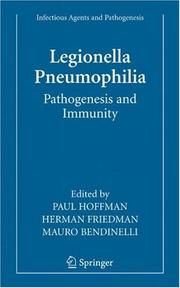
ISBN: 1281117021 9786611117023 0387708960 0387708952 144194365X Year: 2007 Publisher: New York ; London : Springer,
Abstract | Keywords | Export | Availability | Bookmark
 Loading...
Loading...Choose an application
- Reference Manager
- EndNote
- RefWorks (Direct export to RefWorks)
Legionella pneumophila is an emerging human pathogen that resides in natural environments as a parasite of freshwater. There have been new developments in this field including the publication of three whole genome sequences, the discovery of a developmental cycle and novel cyst-like highly infectious form, and the bacteria have been used as a probe for macrophage cellular function to unravel fundamental new knowledge in the area of cellular biology. Legionella has also become a model system for the study of innate as well as adaptive immunity. Information on Legionella continues to increase in the U.S. and abroad. Columbia University has started the first Legionella Genome Project with a multi-million dollar grant from the NIH. In addition, The European Working Group for Legionella infections was formed in 1986. Members are scientists with an interest in improving knowledge and information on the clinical and environmental aspects of legionnaires' disease through developments in diagnosis, management and treatment of the disease. The volume brings together all of the latest research on this pathogen, the interest in which is rapidly growing.
Legionella pneumophila. --- Legionnaires' disease bacterium --- Life sciences. --- Immunology. --- Infectious diseases. --- Microbiology. --- Life Sciences. --- Infectious Diseases. --- Legionella --- Emerging infectious diseases. --- Emerging infections --- New infectious diseases --- Re-emerging infectious diseases --- Reemerging infectious diseases --- Communicable diseases --- Immunobiology --- Life sciences --- Serology --- Microbial biology --- Biology --- Microorganisms
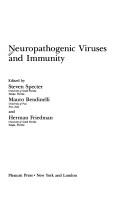
ISBN: 0306437856 1468458884 1468458868 Year: 1992 Volume: vol *4 Publisher: New York London Plenum Press
Abstract | Keywords | Export | Availability | Bookmark
 Loading...
Loading...Choose an application
- Reference Manager
- EndNote
- RefWorks (Direct export to RefWorks)
Nervous system --- Infections --- Immunological aspects --- Virus diseases --- Nervous system - Infections - Immunological aspects. --- Virus diseases - Immunological aspects. --- NERVOUS SYSTEM DISEASES --- VIRUSES --- ETIOLOGY --- IMMUNOLOGY --- PATHOGENECITY
Book
ISBN: 9780387779447 0387779434 9780387779430 9786611954192 1281954195 0387779442 Year: 2008 Publisher: New York : Springer,
Abstract | Keywords | Export | Availability | Bookmark
 Loading...
Loading...Choose an application
- Reference Manager
- EndNote
- RefWorks (Direct export to RefWorks)
There is currently increasing interest concerning the biology and disease caused by Acinetobacter species. Such interest, however, developed relatively slowly because of the necessity to clarify the confusing taxonomy of these organisms. Much work was needed to identify various species as members of this genus, to recognize their epidemiologic profile, their pathogenic role and their increasing importance as multi-antibiotic resistant organisms. In recent years improvement of genetic approaches, recognition of plasmids, integrons and chromosomal sources of resistance mechanisms aroused interest on the role of Acinetobacters in disease by many microbiologists and clinicians, especially internists and infectious disease specialists. In this regard, physicians are frequently confronted with extremely difficult therapeutic approaches for treatment and prevention of severe nosocomial infections due to multi antibiotic resistant Acinetobacter. Moreover, recent observations of community acquired infections have been reported, especially in patients with various risk factors such as immuno-deficiencies. Also, it is now becoming evident that Acinetobacter infections occur frequently in violent situations such as earthquake or war zones. The mechanisms of Acinetobacter virulence are becoming increasingly clear, providing new insights into their pathogenic role in community acquired infections. It is apparent the time is appropriate for detailed review of the increasing knowledge concerning important new information, both clinical and therapeutic, especially information concerning virulence, resistance mechanisms and typing of Acinetobacter spp. Many new findings are accumulating in almost an exponential manner since publication of previous books on this subject in 1991 and 1996.
Life Sciences. --- Microbiology. --- Immunology. --- Virology. --- Life sciences. --- Medical virology. --- Sciences de la vie --- Immunologie --- Virologie médicale --- Microbiologie --- Acinetobacter infections. --- Acinetobacter. --- Nosocomial infections. --- Acinetobacter infections --- Acinetobacter --- Nosocomial infections --- Moraxellaceae Infections --- Biology --- Moraxellaceae --- Infection --- Anti-Infective Agents --- Therapeutic Uses --- Gram-Negative Aerobic Rods and Cocci --- Gram-Negative Bacterial Infections --- Bacterial Infections and Mycoses --- Biological Science Disciplines --- Gammaproteobacteria --- Gram-Negative Aerobic Bacteria --- Bacterial Infections --- Natural Science Disciplines --- Diseases --- Proteobacteria --- Pharmacologic Actions --- Disciplines and Occupations --- Bacteria --- Gram-Negative Bacteria --- Chemical Actions and Uses --- Chemicals and Drugs --- Organisms --- Acinetobacter Infections --- Microbiology --- Anti-Bacterial Agents --- Cross Infection --- Health & Biological Sciences --- Microbiology & Immunology --- Hospital-acquired infections --- Hospital infections --- Acinetobacter diseases --- Colloides --- Herella --- Mimae --- Iatrogenic diseases --- Gram-negative bacterial infections --- Neisseriaceae
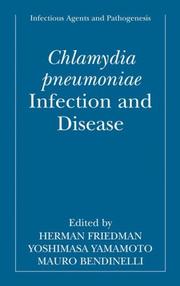
ISBN: 1280460601 9786610460601 0306487411 0306484870 Year: 2005 Publisher: United States of America : Springer Science + Business Media, Inc.,
Abstract | Keywords | Export | Availability | Bookmark
 Loading...
Loading...Choose an application
- Reference Manager
- EndNote
- RefWorks (Direct export to RefWorks)
Chlamydia pneumoniae is a bacteria that is most commonly known for causing colds and pneumonia. However, researchers have recently found a link between C. pneumoniae and atherosclerosis, a clogging of the arteries that causes heart attack and stroke. In addition, ongoing research is showing that certain strains may play a role in asthma, multiple sclerosis, Alzheimer's disease, and arthritis. This volume, part of the Infectious Agents and Pathogenesis series, is a complete portrait of C. pneumoniae and what is currently known about it.
Chlamydophila pneumoniae infections. --- Chlamydophila pneumoniae. --- Immunology. --- Microbiology. --- Emerging infectious diseases. --- Morphology (Animals). --- Biochemistry. --- Infectious Diseases. --- Animal Anatomy / Morphology / Histology. --- Biochemistry, general. --- Infectious diseases. --- Animal anatomy. --- Biological chemistry --- Chemical composition of organisms --- Organisms --- Physiological chemistry --- Biology --- Chemistry --- Medical sciences --- Animal anatomy --- Animals --- Physiology --- Microbial biology --- Microorganisms --- Immunobiology --- Life sciences --- Serology --- Composition --- Anatomy
| Listing 1 - 10 of 29 | << page >> |
Sort by
|

 Search
Search Feedback
Feedback About UniCat
About UniCat  Help
Help News
News